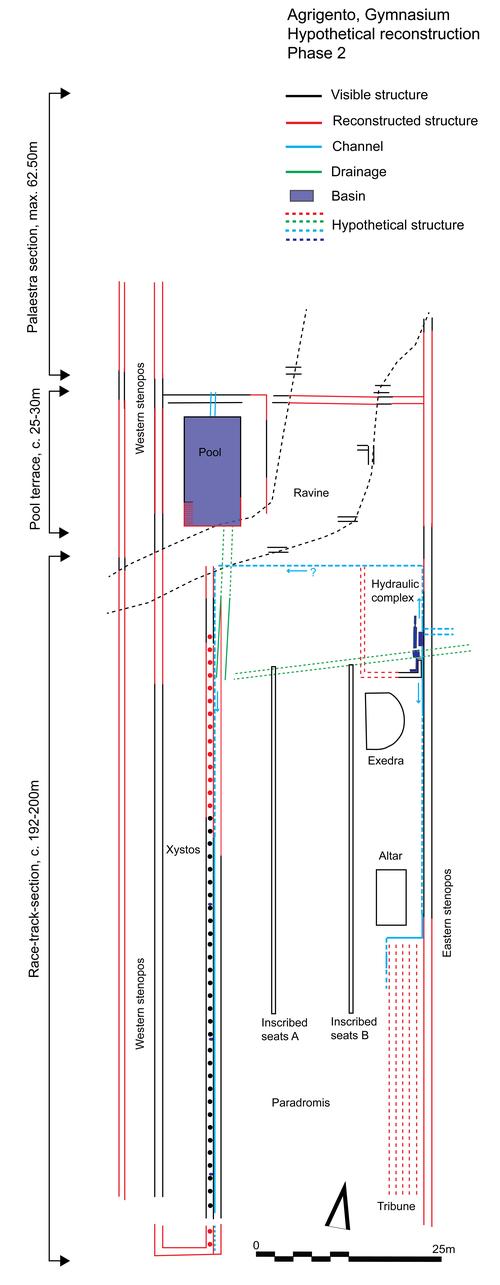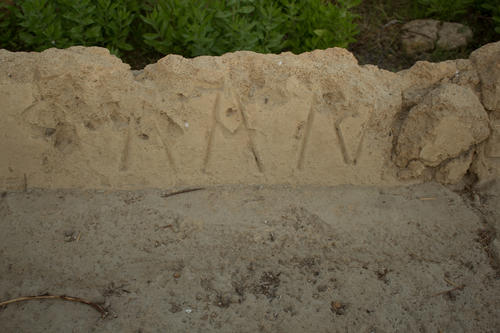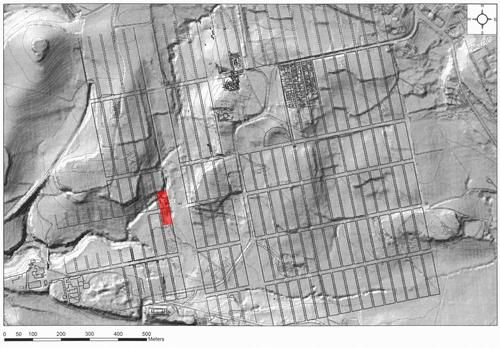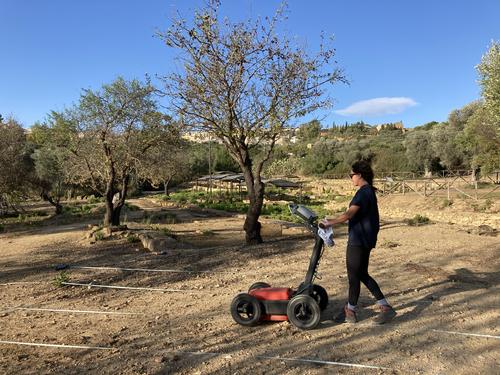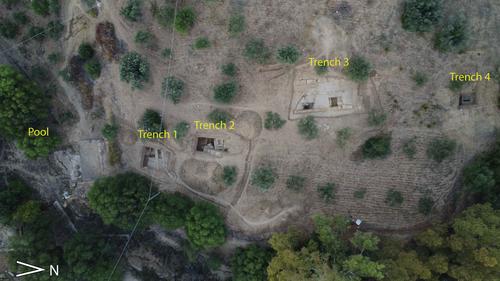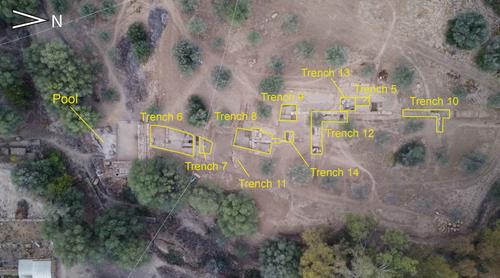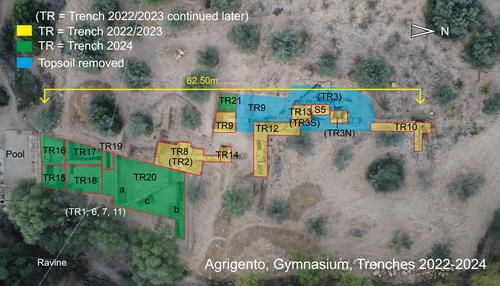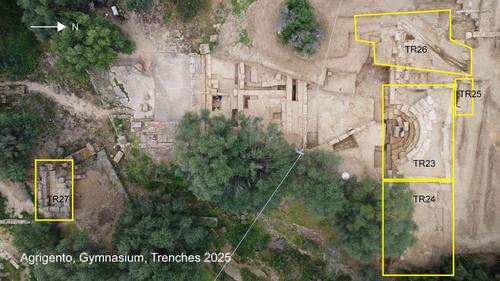Agrigento: Gymnasium
Fig. 01: Agrigento, Gymnasium. Hypothetical reconstruction of phase 2, Augustan period;
Bildquelle: M. Trümper
Fig. 02: Inscribed seats B in the paradromis with inscription of the Augustan period
Bildquelle: M. Trümper
Fig. 03: Hypothetical reconstruction of the urban grid with indication of the area of the gymnasium
Bildquelle: Brienza 2017, 27 fig. 2
Fig. 04: GPR survey south of the gymnasium
Bildquelle: S. Kay
Fig. 05: Location of trenches in 2022
Bildquelle: M. Trümper
Fig. 06: Location of trenches in 2023
Bildquelle: Th. Lappi, M. Trümper
Fig. 07: Location of trenches in 2024
Bildquelle: Th. Lappi, M. Trümper
Fig. 08: Location of trenches in 2025
Bildquelle: Th. Lappi, M. Trümper
SUMMARY
This project was initiated in 2019 under the direction of Monika Trümper and Thomas Lappi, in cooperation with the Parco Archeologico e Paesaggistico della Valle dei Templi di Agrigento, the British School at Rome, and the Politecnico di Bari. It aims to investigate the gymnasium and a bath building, both located in the center of the large ancient city. While the temples and sanctuaries of Agrigento have long attracted research interest, the city itself has only recently come into focus thanks to an impressive program launched by the Parco Archeologico e Paesaggistico della Valle dei Templi di Agrigento (see, e.g., Caliò et al. 2017; Caminneci – Parello 2019; Caminneci et al. 2015, 2016, 2017, 2018a, 2018b, 2019a, 2019b, 2020). Our project contributes to this new program and to a better understanding of the ancient city of Agrigento.
FUNDING
The project has been generously funded by the Freie Universität Berlin, the Ernst-Reuter-Gesellschaft der Freien Universität Berlin, and the Politecnico di Bari in 2020 and 2022, and by the German Research Foundation (Deutsche Forschungsgemeinschaft) from 2023 to 2025. Thanks to the Erasmus+ Staff Mobility for Teaching program we were able to conduct an on-site field school from 2023 to 2025 in collaboration with the Politecnico di Bari, bringing together students from both universities.
PRESS
You will find the press review here.
STATE OF RESEARCH
The gymnasium in Agrigento is one of the most important, if not the most important gymnasium in Sicily and the western Mediterranean more generally, because of its size, design, and chronology (fig. 1). Parts of a race-track section and a pool, located on either side of a small ravine, have been excavated between the 1950s and 2005 and published in several preliminary reports (Griffo 1963; De Waele 1971; Moretti 1976; Fiorentini 1992, 1993/1994, 1997/1998) and two final reports by Graziella Fiorentini (Fiorentini 2009, 2010). The race-track section originally covered in an east-west direction one insula lot of 35 m width, between two stenopoi (cardines), and over 200 m in north-south direction. It included a stoa/porticus of 7 m width (xystos), an open race-track of about 17 m width (paradromis) subdivided by two facing rows of inscribed seats (45 and 47 m long), a hydraulic complex, an exedra-shaped structure, an altar, and possibly a tribune with seats. The context of the pool section and its extension to the north are unknown.
Fiorentini proposed that the gymnasium was built in the late Hellenistic period when the city saw a major monumentalizing transformation, but this cannot yet be substantiated by evidence. Stratigraphy and inscriptions (fig. 2) suggest that the currently visible remains belong to the Augustan period when the gymnasium was significantly remodeled, if not built (Trümper 2020a). Despite extensive excavation and publications, several questions remain open:
- the extension, design, and most notably the existence and location of a palestra, which is to be expected in a complex with such a sophisticated race-track system;
- chronology;
- idiosyncratic features (water management and unusual features such as the hydraulic complex, the exedra-shaped structure, and the altar);
- urban context (significance in the urban space).
The fact that few gymnasia/palaestrae have been securely identified in the archaeological record of Sicily and other regions of the western Mediterranean and that none of them includes a race-track complex underlines the importance of the complex in Agrigento (Trümper 2018, 2020b). Therefore, it seems particularly worthwhile and important to further explore this building and to answer the above-mentioned questions.
Closely related to the gymnasium, which commonly served for the athletic and intellectual training of male citizens and the grooming and training of the body, are bath buildings, particularly in the Imperial period when lavish baths and gymnasia were even merged (Trümper 2015, 2019). A small bath building dating to the late antique period has recently been identified and excavated by the Parco Archeologico e Paesaggistico della Valle dei Templi di Agrigento in the Quartiere ellenistico-romano. Traces of another small bath building have been identified in a yet unexplored olive grove to the north of the Tempio ellenistico-romano. Two apses, traces of pools, and a channel suggest that this was a bath building. The size and wall technique speak for a late date, comparable to that of the bath building in the Quartiere ellenistico-romano. The building requires further research to better assess its size, design, date, and urban context.
FIELDWORK
2019
The Freie Universität Berlin began a new research project in October 2019, in cooperation with the above-mentioned partners. Unfortunately, the COVID-19 pandemic delayed the originally planned fieldwork seasons, particularly in the bath building.
2020
A first campaign served to survey the terrain of both buildings and materials stored in archives. Based on this survey a geophysical survey was carried out in October 2020 in cooperation with Stephen Kay and Elena Pomar from the British School at Rome: the survey covered the area of the gymnasium and the bath building to the north of the Tempio ellenistico-romano, with the aim to reconstruct urban infrastructure in these areas (figs. 3-4). The geophysical survey recorded a series of archaeological features which reveal the presence of structures organized in accordance with the orthogonal city plan. At the same time, a first architectural survey was carried out in cooperation with Antonello Fino from the Politecnico di Bari to include all structures that are currently visible in one plan. A third pillar of the research in 2020 was the identification of documentation and findings, stored in the archive of the Parco Archeologico e Paesaggistico della Valle dei Templi di Agrigento. Until today, no findings of previous excavations have been published to support the chronology of the gymnasium. The findings will be studied for the crucial phases and contexts of the gymnasium to put the chronology on stable grounds.
The campaign was generously funded by the Freie Universität Berlin. The results were published in a preliminary report in the Archäologischer Anzeiger 2022 (Trümper et al. 2022).
2022
Based on the results of the architectural and geophysical surveys, a first excavation campaign was carried out and the architectural survey was continued, from 12 September to 7 October 2022 (fig. 5).
Report of the 2022 Season (pdf)
2023
A second excavation campaign was carried out and the architectural survey was continued, from 28 August to 7 October 2023 (fig. 6).
Report of the 2023 Season (pdf)
2024
A third excavation campaign was carried out and the architectural survey was continued, from 2 September to 18 October 2024 (fig. 7).
2025
A fourth excavation campaign was carried out and the architectural survey was continued, from 24 February to 1 April 2025 (fig. 8).
Report of the 2024 and 2025 Seasons (pdf)
TEAM
- Chiara Blasetti Fantauzzi, Freie Universität Berlin
- Antonello Fino, Politenico Bari
- Stephen Kay, British School at Rome
- Thomas Lappi, Freie Universität Berlin
- Elena Pomar, British School at Rome
- Paola Santospagnuolo, Freie Universität Berlin
- Monika Trümper, Freie Universität Berlin
This project could not be carried out without the generous permission, support, and cooperation of the Parco Archeologico e Paesaggistico della Valle dei Templi di Agrigento. Particular thanks are owed to Dr. Maria Concetta Parello and Arch. Roberto Sciarratta, direttore del Parco.
Link to Fastionline: https://www.fastionline.org/record_view.php?fst_cd=AIAC_5018
BIBLIOGRAPHY
Caliò et al. 2017: L. Caliò – V. Caminneci – M. Liviadiotti (eds.), Agrigento. Nuove richerche sull'area pubblica centrale (Rome 2017)
Caminneci – Parello 2019: V. Caminneci – M. C. Parello, Agrigentum (Agrigento). L'impianto termale, in: M. Medri – A. Pizzo (eds.), Le terme pubbliche nell'Italia romana (II secolo a.C. - fine IV d.C.). Architettura, tecnologia e società (Roma 2019) 21-32
Caminneci et al. 2015: V. Caminneci – M. C. Parello – M. S. Rizzo (eds.), Agrigento romana. Scavi e ricerche nel quartiere ellenistico romano. Campagna 2013 (Palermo 2015)
Caminneci et al. 2016: V. Caminneci – M. C. Parello – M. S. Rizzo (eds.), Paesaggi urbani tardoantichi. Casi a confronto. Atti delle Giornate gregoriane, VIII edizione (Bari 2016)
Caminneci et al. 2017: V. Caminneci – M. C. Parello – M. S. Rizzo (eds.), La persistenza della memoria. Vivere il paesaggio storico. IX Giornate Gregoriane (Rome 2017)
Caminneci et al. 2018a: V. Caminneci – M. C. Parello – M. S. Rizzo (eds.), Agrigento ellenistico-romana. Coscienza identitaria e margini di autonomia. Atti della Giornata di studi (Bari 2018)
Caminneci et al. 2018b: V. Caminneci – M. C. Parello – M. S. Rizzo (eds.), La città che produce. Archeologia della produzione negli spazi urbani. Atti delle Giornate Gregoriane X edizione (Bari 2018)
Caminneci et al. 2019a: V. Caminneci – M. C. Parello – M. S. Rizzo, Il contributo degli scavi del teatro di Agrigento per una rilettura degli edifici teatrali della Sicilia ellenistica. - in: M. Trümper – G. Adornato – T. Lappi (eds.), Cityscapes of Hellenistic Sicily (Rome 2019) 101-112
Caminneci et al. 2019b: V. Caminneci – M. C. Parello – M. S. Rizzo (eds.), Theaomai. Teatro e società ellenistica. Atti delle XI Giornate gregoriane (Firenze 2019)
Caminneci et al. 2020: V. Caminneci – M. C. Parello – M. S. Rizzo (eds.), Le forme dell'acqua. Approvvigionamento, raccolta e smaltimento nella città antica. Atti delle Giornate Gregoriane XII edizione (Bologna 2020)
De Waele 1971: J. de Waele, Acragas Graeca. Die historische Topographie des griechischen Akragas auf Sizilien, Archeologische studien van het Nederlands Historisch Instituut te Rome (Den Haag 1971)
Fiorentini 1992: G. Fiorentini, Agrigento. Agorà inferiore e ginnasio nei recenti scavi, QuadAMess 7, 1992, 5-9
Fiorentini 1993/1994: G. Fiorentini, Attività di indagini archeologiche della Soprintendenza Beni Culturali e Ambientali di Agrigento, Kokalos 39/40, 1993/1994, II 1, 717-733
Fiorentini 1997/1998: G. Fiorentini, Problemi e linee di ricerca archeologica in territorio di Agrigento e provincia, Kokalos 43/44, 1997/1998, 3-15
Fiorentini 2009: G. Fiorentini, Il ginnasio di Agrigento, SicAnt 6, 2009, 71-109
Fiorentini 2011: G. Fiorentini, Il ginnasio, in: E. De Miro – G. Fiorentini (eds.), VI. Agrigento Romana. Gli edifici pubblici civili (Pisa 2011) 71-95
Griffo 1963: P. Griffo, Contributi epigrafici agrigentini, Kokalos 9, 1963, 163-184
Moretti 1976: L. Moretti, Epigraphica, 14. Un ginnasio per Agrigento, RFil 104, 1976, 182-186
Parello 2018: M. C. Parello, Il Ginnasio di Agrigentum, in: V. Caminneci (ed.), Cura ut valeas. Nel corpo e nello spirito (Agrigento 2018) 73-89
Trümper 2015: M. Trümper, Modernization and Change of Function of Hellenistic Gymnasia in the Imperial Period: Case-studies Pergamon, Miletus, and Priene, in: P. Scholz – D. Wiegandt (eds.), Das Kaiserzeitliche Gymnasium (Berlin 2015) 167-221
Trümper 2018: M. Trümper, Gymnasia in Eastern Sicily of the Hellenistic Period. A Reassessment, in: U. Mania – M. Trümper (eds.), Development of Gymnasia and Graeco-Roman Cityscapes (Berlin 2018) 43-73 < DOI: 10.17171/3-58-3>
Trümper 2019: Development of Bathing Culture in Hellenistic Sicily, in: M. Trümper – G. Adornato – Th. Lappi (eds.), Cityscapes of Hellenistic Sicily (Rome 2019) 347-391
Trümper 2020a: M. Trümper, Water Luxury in the Gymnasium of Agrigento, in: V. Caminneci – M. C. Parello – M. S. Rizzo (eds.), Le forme dell’acqua. Approvvigionamento, raccolta e smaltimento nella città antica. XII Giornate Gregoriane, Agrigento (Bologna 2020) 171-184
Trümper 2020b: M. Trümper, Gymnasia in Hellenistic and Roman Sicily – A Critical Reassessment of Typology and Function, in: L. Fuduli – V. Lo Monaco (eds.), Megiste kai ariste nesos. Symposion on the Archaeology of Sicily. University of São Paulo, 3-5 April 2019 (Rome 2020) 47-71
Trümper 2024: M. Trümper, Gymnasia in Sicily Between the Civil Wars and the Julio-Claudian Period, in: L. Caliò – L. Campagna – E. C. Portale – L. Sole (eds.), La Sicilia fra le guerre civili e l’epoca giulio-claudia (Rome 2024) 255–282
Trümper et al. 2024a: M. Trümper – T. Lappi – A. Fino, Il Ginnasio di Agrigento, in: M. C. Parello (eds.), L’isola dei tesori. Ricerca archeologica e nuove acquisizioni. Atti del Convegno Internazionale (Agrigento, Museo Archeologico Regionale „Piero Griffo“, 14-17 dicembre 2023) (Bologna 2024) 555–562
Trümper 2025a: M. Trümper, Aqueducts and Bathing: Investment Strategies of South Italian and Sicilian Cities Between the 5th Century BC and the Early Imperial Period, in: V. Caminneci – M. Parello (eds.) Primordia rerum. La città e il suo ambiente naturale. XV Giornate Gregoriane (forthcoming 2025)
Trümper 2025b: M. Trümper, The Gymnasium in the Hellenistic West, in: A. Kottaridi (ed.), Beyond Macedonia: The Multifaceted Hellenistic Oikoumene Reconsidered. Conference, Aigai 27 May – 2 June 2022 (forthcoming 2025)
Trümper et al. 2025: M. Trümper – Th. Lappi – A. Fino, The Gymnasium of Agrigento: Changes in Design, Training Activities, and Cultic Practices, in: G. Mouratidis – N. Kazakidi (eds.), Education in and Beyond the Greek Gymnasium (forthcoming 2025)

